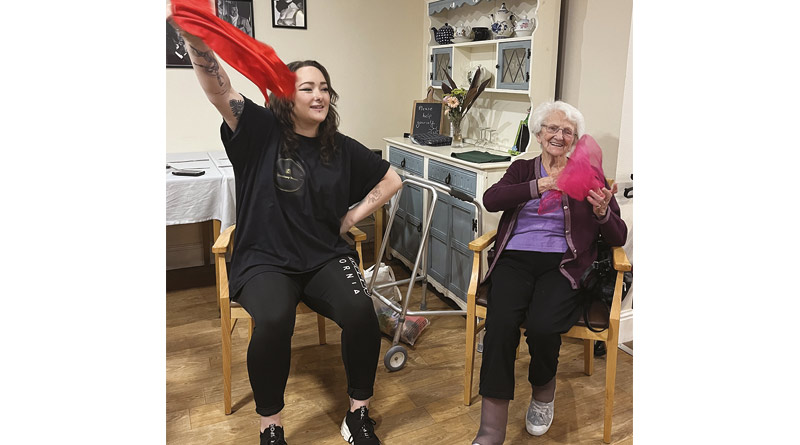The Benefits Of Dance For Dementia – Promoting Positive Connections And Increasing Mental Well-Being
By Chloe Morrisey, Activities Co-Ordinator at Orchard Care Homes’ Penwortham Grange and Lodge
Keen to bring some exercise innovation and variety to the lives of people in the care home she works for, Chloe Morrisey, Activities Co-Ordinator at Orchard Care Homes’ Penwortham Grange and Lodge, Preston, draws on her dance background to get everyone moving. Here, Chloe explains the benefits of dance for all and how it can help to build connection and confidence amongst those living with dementia.
I am a great believer in exercise for life for all. Exercise is important for our physical and mental well-being. It can improve strength, flexibility, balance, and coordination, as well as reduce the risk of chronic health conditions like heart disease, diabetes, and obesity. I’ve seen how dance can really benefit those in care homes, proving that exercise at any time of life is vital to enhance the fitness levels of people of all ages, shapes, and sizes.
At Penwortham Lodge and Grange, I have been delivering bespoke dance workshops and activities for everyone at our home over the past two years and have noticed an improvement in overall psychological and mental well-being – which is especially important for those with dementia.
Dance has positive effects on people with dementia as it boosts the sympathetic nervous system and the hypothalamic-pituitary-adrenal axis, while also enhancing neurotransmission to the brain. As a great mood lifter, dancing can help to elevate levels of serotonin, dopamine, endorphins, and norepinephrine. It plays a critical role in movement memory, enabling people living with dementia to access and express emotions and memories that are stored in the body – even though they may experience cognitive, psychological, or physical limitations. For those who have difficulty communicating verbally, movement-based communication offers a valuable alternative to show connection and expression.
During my degree in Dance Performance and Teaching at the University of Central Lancashire, I became interested in how dance activities can help people who live in care homes.
I began researching ways to facilitate dance effectively in an inclusive and person-centered way – which is so important in day-to-day life among residents. I enjoyed experimenting with different techniques and observing dance experts by shadowing various practitioners in my community, including Dr. Melanie Brierley’s “Connect + Flow” session for people with Parkinson’s in Preston. These sessions were a great source of inspiration and led me to pursue a career combining care and dance.
One aspect which really appealed to me was how an individual’s physical, cognitive, emotional, social, and spiritual needs can be met through dance and the way groups can come together to express themselves. Through working at Orchard, I have been able to implement some of these techniques and gain a deeper understanding of the individual health and mobility needs of residents so that I can tailor my dance workshops to be as inclusive as possible.
My role at Orchard gives me immense satisfaction as I get to create spaces that promote social interaction. It’s wonderful to exchange skills with everyone, and I find that some people have vast experience to offer. I enjoy teaching new skills and routines and take pleasure in providing a safe and inclusive space for everyone in my well-being and somatic workshops. I always encourage everyone to explore their creativity and self-expression, aiming to strengthen connections in their mind, body, and spirit.
For people with less mobility, I adapt routines and exercises. These can include seated exercises or stretching, which helps to improve flexibility and reduce stiffness.
Generally, the suggested exercise target each week for people over 65 is two and a half hours of moderate activity. However, I prefer to personalise plans to fit each person’s unique needs and fitness capacities. If someone has difficulty meeting the recommended physical activity targets, I may adopt a lower intensity level or shorter time frame, then try to gradually build on this.
I’d recommend dance as a motivational booster for people in care homes – for both staff and residents alike. It’s so much fun and adds a real variety to the types of activities on offer such as craft, gardening or bingo. Whilst these are fun too, dance and music can bring back so many memories and feelings which is wonderful to see. I am really pleased to be able to combine my love of dance with my passion for care. It’s a winning combination for me!

